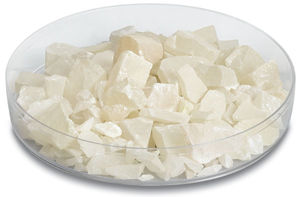Difference between revisions of "Zinc sulfide"
(Added image) |
|||
| Line 6: | Line 6: | ||
Zinc sulfide can be roasted to release [[sulfur dioxide]], leaving [[zinc oxide]] behind. | Zinc sulfide can be roasted to release [[sulfur dioxide]], leaving [[zinc oxide]] behind. | ||
| − | :2 ZnS + 3 O<sub>2</sub> → 2 ZnO + 2 SO<sub>2</sub> | + | : 2 ZnS + 3 O<sub>2</sub> → 2 ZnO + 2 SO<sub>2</sub> |
===Physical=== | ===Physical=== | ||
| Line 37: | Line 37: | ||
===Disposal=== | ===Disposal=== | ||
| − | Zinc sulfide doesn't require special disposal, though it can be neutralized with hydrogen peroxide. | + | Zinc sulfide doesn't require special disposal, though it can be neutralized with hydrogen peroxide. Avoid dumping it with acids though. |
==References== | ==References== | ||
Revision as of 16:29, 21 June 2016
Zinc sulfide (or zinc sulphide) is a chemical with the chemical formula ZnS. Zinc sulfide fluoresces green, and is employed most often for its phosphorescent properties.
Contents
Properties
Chemical
Zinc sulfide can be roasted to release sulfur dioxide, leaving zinc oxide behind.
- 2 ZnS + 3 O2 → 2 ZnO + 2 SO2
Physical
Zinc sulfide is a white-yellowish solid, and it is widely used as a pigment. In its dense synthetic form, zinc sulfide can be transparent, and it is used as a window for visible optics and infrared optics. ZnS has a density of 4.090 g/cm3. It is poorly soluble in water but more soluble in acids. ZnS boils at 1,185 °C.
Availability
Zinc sulfide can be purchased from various science shops, as glowing powder.
Higher purity ZnS can be purchased from various chemical suppliers.
Preparation
Zinc sulfide is often produced by reacting zinc oxide with hydrogen sulfide, which produces zinc sulfide and water. Another method for producing the chemical is by heating a solution of zinc sulfate with sodium thiosulfate. A third way is to make a equimolar mix of zinc and sulfur powders and ignite the mix. This produces a bright green flame and impure ZnS. The impure ZnS can be purified through decantation.
Uses
Zinc sulfide can be used to produce hydrogen sulfide in a lab by the reaction with hydrochloric acid. The reaction proceeds as such:
- ZnS + 2HCl → ZnCl2 + H2S
Projects
- Make glowing powder
- Hydrogen sulfide production
- Sulfur dioxide generation
Handling
Safety
Zinc sulfide dust is irritant to the eyes, skin, if inhaled or ingested. In case of ingestion, it will release toxic hydrogen sulfide.
Storage
Zinc sulfide does not require special storage, although it should be kept away from any strong acid vapors, as it will release hydrogen sulfide gas on contact.
Disposal
Zinc sulfide doesn't require special disposal, though it can be neutralized with hydrogen peroxide. Avoid dumping it with acids though.
